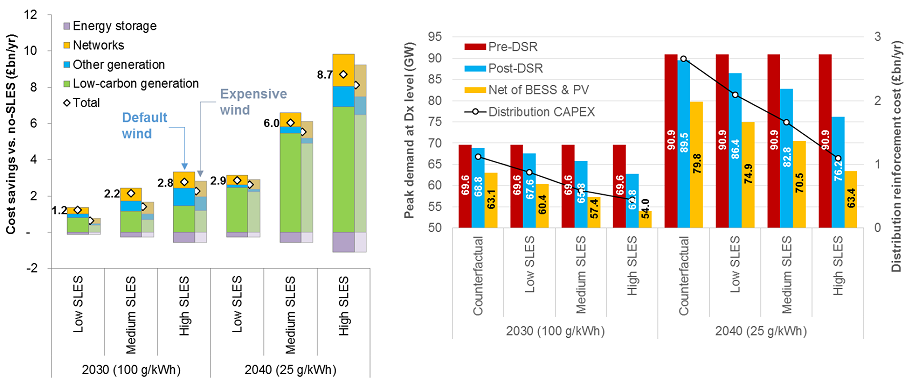By Marko Aunedi and Tim Green, Imperial College, London
While it is clear that Smart Local Energy Systems (SLES) may provide a range of benefits to local communities, contributing to their economic, environmental and social objectives, there is a variety of benefits that SLES could also offer to the national energy system on its pathway to decarbonisation.
The current centralised energy system presents a number of barriers to using decentralised assets to provide flexibility, which is why SLES offer the potential for decentralised flexibility.
As part of EnergyREV, a team at Imperial College London have been carrying out whole-system modelling to investigate the magnitude and nature of the contribution that SLES can make to both local and national energy objectives, with a particular focus on the whole-system benefits of local flexibility resources that might be unlocked and enhanced by SLES.
To assess these benefits, our Whole-electricity System Investment Model (WeSIM) has been used and cost savings from SLES deployment for 2030 and 2040 scenarios have been calculated, assuming the transition to a low- or zero-carbon energy system. We have assumed that SLES deliver an enhanced uptake of demand-side response (DSR) and distributed battery energy storage.
Results
Our results show that SLES lead to significant cost savings in the wider system. All SLES deployment levels – Low (10% of uptake relative to total demand), Medium (25%) or High (50%) – show a saving in total system cost compared to the no-SLES Counterfactual, in both time horizons (see figure below). Much higher cost savings are achieved in the 2040 case where the flexibility offered by SLES enables large savings in the cost of the low-carbon generation that is needed to meet the lower carbon emissions target of 25 g/kWh.
With a 100 gCO2/kWh emissions target in 2030, we found that the average cost of electricity could reduce from 9.5 p/kWh in the no-SLES case to 9.2 p/kWh at 10% SLES penetration, and to 8.7 p/kWh at 50% SLES penetration. Here the cost per kWh covers owning and operating generation and networks; retail prices would include additional costs and be higher. With a more strict emissions limit of 25 gCO2/kWh in 2040 the average cost was found to reduce from 10.3 p/kWh in no-SLES case to 9.7 p/kWh at 10% SLES uptake, and to 8.4 p/kWh at 50% SLES uptake.
We have found that initial investments in flexible resources deliver the highest benefits, whereas further additions result in diminishing, although still substantial, contributions to cost savings. For instance, increasing the SLES uptake in 2040 by 2.5 times (from Low to Medium) and 5 times (Low to High) increases the benefits by a factor of 2.1 and 3.0, respectively.
SLES continue to show benefits even when the cost of enabling demand side response (DSR) vary. For instance, at Medium SLES uptake in the 2040 system, the cost of implementing DSR would have to reach about £600 per kilowatt of flexible power to diminish the net benefits of SLES by 10%; in a more extreme case, the investment cost of DSR would have to increase to a highly unlikely level of £6,000 per kilowatt to completely wipe out the net benefit of SLES.
The savings from substituting wind for carbon capture and storage (CCS) capacity remain substantial even if the cost of wind does not fall by as much as expected by 2040. In this case, the system benefits of SLES in 2040 only reduce by 7-8%.
SLES reduce the need for investing in electricity generation and the local and national network infrastructure. The use of DSR and local storage reduces the net peak loading of the power system infrastructure, allowing the demand to be met with less installed generation capacity and less network capacity while maintaining the same level of security of supply. On the generation side, this effect is seen as a reduced need for peaking.
The flexibility made possible by SLES has a very significant effect on net peak demand (see figure below). In 2040 the net peak loading of the distribution grid, after accounting for actions of DSR, energy storage and local PV generation reduces from 80 GW for the no-SLES case to 63 GW for High SLES case. This also results in substantially lower cost of distribution network reinforcement, which reduces from £2.7bn per year in the Counterfactual case to £1.1bn per year in the High SLES case.
Cost savings from the flexibility provided by SLES are affected by realisation of domestic DSR through other means outside SLES. A 20% uptake level of non-SLES DSR in 2040 still allows SLES to create cost savings of £6.8bn/year at 50% penetration (a 20% fall from £8.7bn/year).
Where next?
Obviously, the system benefits of SLES quantified here are driven by the underlying assumption that SLES can unlock and enhance flexibility from highly distributed resources such as residential DSR and small-scale battery storage.
Going forward, we want to explore how realistic these assumptions are in light of the insights gained from PFER demonstrators and analysis of SLES in other areas. We will also be looking in more detail into how the benefits of SLES are affected by costs of key technologies such as batteries and renewable generation, as well as by the level of dispersion of SLES assets in a given geographic area.
A more detailed description of our analysis is provided in our briefing paper, “Early Insights into System Impacts of Smart Local Energy Systems”, which is available online
